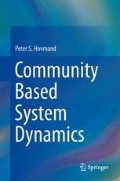Abstract
This chapter introduces community-based system dynamics (CBSD), its underlying motivations, and some key concepts. Central to this argument is the idea that communities need to be involved to both inform a better understanding of the underlying system and create the support for implementing recommendations based on system models. The chapter then outlines the ways that problems can be complex and resists solutions and how causal maps and formal models with computer simulation can help improve our mental models. Participation is then defined as a process within the context of CBSD.
Logical pictures can depict the world.
(Wittgenstein 1974, 10)
Today’s knowledge about something is not necessarily the same tomorrow. Knowledge is changed to the extent that reality also moves and changes. Then theory also does the same. It’s not something stabilized, immobilized.
(Horton and Freire 1990, 101)
One way to focus on this problem is to discover that we have no conception of objectivity that enables us to distinguish the scientifically ‘best descriptions and explanations’ from those that fit most closely (intentionally or not) with the assumptions that elites in the West do not want critically examined.
(Harding 1991, 97)
Access this chapter
Tax calculation will be finalised at checkout
Purchases are for personal use only
Notes
- 1.
It is important to note that this lag between results and policy implementation is by no means unique to system dynamics. In fact, it is common in many areas of scientific research with whole new fields emerging such as translational science and implementation science to address this lag.
- 2.
Some have characterized the approach as better described as community driven, while others would see this fitting under the umbrella term of community-engaged research, but neither of these emphasize the importance of basing activities in a community in a way that facilitates accumulation over time. Hence, I prefer the term “community based,” and it is consistent with the common usage of a community-based participatory research (Minkler and Wallerstein 2008).
- 3.
The earliest articulation of this appeared in Hovmand et al. (2008) with work funded by the National Science Foundation (SES-0724577) and the Missouri Transformation Project, funded by the Substance Abuse Mental Health Services Administration Mental Health Transformation State Incentive Grant (McFarland, Chair; Goon, Co-Chair; SM57474- 01).
References
Austin, J. L. (1962). How to do things with words (2nd ed.). Cambridge, MA: Harvard University Press.
Black, M. (1962). Models and metaphors: Studies in the language and philosophy. Ithaca, NY: Cornell University Press.
Dörner, D. (1997). The logic of failure: Recognizing and avoiding error in complex situations. New York, NY: Basic Books.
Doyle, J. K., & Ford, D. N. (1998). Mental models concepts for system dynamics research. System Dynamics Review, 14, 3–29.
Dudley, R. G., Sheil, D., & Colfer, C. (2008). Simulating oil palm expansion requires credible approaches that address real issues. Ecology and Society, 13(1), r1.
Fisher, A., & Sonn, C. (2007). Sense of community and dynamics of inclusion-exclusion by receiving communities. The Australian Community Psychologist, 19(2), 16–34.
Forrester, J. W. (1969). Urban dynamics. Cambridge, MA: MIT Press.
Forrester, J. W. (1990). Principle of systems. Waltham, MA: Pegasus Communications. Original edition, 1971.
Forrester, J. W. (2007). System dynamics-the next fifty years. System Dynamics Review, 23(2–3), 359–370.
Frye, M. (1983). The politics of reality: essays in feminist theory. Freedom, CA: The Crossing Press.
Harding, S. (1991). Whose science? Whose knowledge: Thinking from women's lives. Ithaca, NY: Cornell University Press.
Heyes, C. (2000). Line drawings: Defining women through feminist practice. Ithaca, NY: Cornell University Press.
Horton, M. and Freire, P. 1990. We make this road by walking: conversations on education and social change. Edited by B. Bell, J. Gaventa and J. Peters. Philadelphia: Temple University Press.
Hovmand, P. S., Ford, D. N., Flom, I., & Kyriakakis, S. (2009). Victims arrested for domestic violence: Unintended consequences of arrest policies. System Dynamics Review, 25(3), 161–181.
Hovmand, P.S., D. F. Gillespie, Diane McFarland, Enola Proctor, Benton Goon, Barbara Levin, and Sally Haywood. 2008. Science meets policy practices. Paper read at 26th International Conference of the System Dynamics Society, at Athens, Greece.
Kumar, S. (2002). Methods for community participation: a complete guide for practitioners. Warwickshire, UK: Practical Action.
Lave, J., & Wenger, E. (1991). Situated learning: Legitimate peripheral participation. Cambridge, UK: Cambridge University Press.
Meadows, D. H. (1991). Global citizen. Washington, DC: Island Press.
Meadows, D., Jørgen, R., & Dennis, M. (2004). Limits to growth: The 30-year update. White River Junction: Chelsea Green Publishing Company.
Minkler, M., & Wallerstein, N. (Eds.). (2008). Community-based participatory research for health: From process to outcomes (2nd ed.). San Francisco, CA: Jossey-Bass.
Moxnes, E. (2000). Not only the tragedy of the commons: misperceptions of feedback and policies for sustainable development. System Dynamics Review, 16(4), 325–348.
Richardson, G. P. (2011). Reflections on the foundations of system dynamics. System Dynamics Review, 27(3), 219–243.
Rouwette, E., Vennix, J. A. M., & van Mullekom, T. (2006). Group model building effectiveness: A review of assessment studies. System Dynamics Review, 18(1), 5–45.
Senge, P. (1990). The fifth discipline. New York, NY: Currency Doubleday.
Stave, K. (2010). Participatory system dynamics modeling for sustainable environmental management: Observations from four cases. Sustainability, 2(27), 2762–2784.
Stave, K. A. (2002). Using system dynamics to improve public participation in environmental decisions. System Dynamics Review, 18(139–167).
Sterman, J. D. (2000). Business dynamics: Systems thinking and modeling for a complex world. New York, NY: Irwin McGraw-Hill.
Wittgenstein, L. (1974). Tractatus logico-philosophicus. New York: Routledge. Translated by D. F. Pears and B. F. McGuinness. Original edition, 1921.
Author information
Authors and Affiliations
Rights and permissions
Copyright information
© 2014 Springer Science+Business Media New York
About this chapter
Cite this chapter
Hovmand, P.S. (2014). Introduction to Community-Based System Dynamics. In: Community Based System Dynamics. Springer, New York, NY. https://doi.org/10.1007/978-1-4614-8763-0_1
Download citation
DOI: https://doi.org/10.1007/978-1-4614-8763-0_1
Published:
Publisher Name: Springer, New York, NY
Print ISBN: 978-1-4614-8762-3
Online ISBN: 978-1-4614-8763-0
eBook Packages: Behavioral ScienceBehavioral Science and Psychology (R0)

